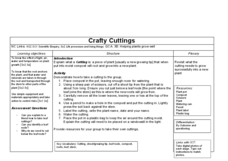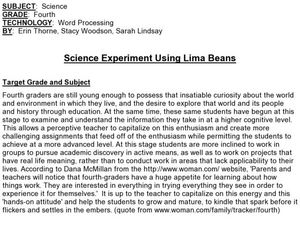Curated OER
Photosynthesis
In this online interactive photosynthesis learning exercise, students respond to 9 multiple choice and fill in the blank questions regarding the information included in the provided paragraphs.
Curated OER
Plants Multiple Choice Activity
In this plant worksheet, students complete a set of 15 multiple choice questions about plants and their growth. A reference web site is given for additional activities.
Curated OER
Plant Parts
Students recognize the parts of the plant and the function it provides.In this plant parts lesson, students participate in three activities relating to plant parts and properties.
Curated OER
What is Rice?
Second graders investigate the agricultural process of rice farming by creating a rice stationary item. In this farming lesson, 2nd graders read about rice plants and the techniques used to harvest the edible plant. Students discuss...
Biology Junction
Introduction to Plants
In this biology lesson, students identify the different types and parts of the plant. They complete a crossword puzzle with 37 questions about plants.
Curated OER
Plant Responses
In this plant response worksheet, students will explore the different responses plants have to different stimuli, including light and gravity. Students will complete 7 multiple choice questions and 3 fill in the blank questions.
Curated OER
Botany: How does the rice plant grow in water?
Second graders read about how rice grows in water and make a rainstick when they are done. In this rice lesson plan, 2nd graders make a rain stick out of rice, posterboard, scissors, glue, and a cardboard tube.
Curated OER
Life Cycle of Trees
For this Life Cycle of Trees worksheet, students read one page about the life cycle of a trees. Students define 12 terms from the reading.
Curated OER
Crafty Cuttings
Young scholars learn how to successfully plant a cutting. In this plant cutting lesson, students understand the steps of making a plant cutting and can explain them to others.
Curated OER
"Cacti" Reading Comprehension-- Informational Passages
In this reading for information worksheet, students read a passage about cacti. Students answer 5 comprehension and 5 vocabulary questions.
Curated OER
Plant Systems
In this plant systems worksheet, students write true or false for the 10 sentences about plant systems. Students then label the parts of the plant.
Curated OER
Pythagorean Theorem
Learners solve problems using the Pythagorean Theorem. For this geometry lesson, students identify the sides and angles of a right triangle. They find the different trigonometric ratios and solve using sine, cosine and tangent.
Curated OER
Parts of a Plant
Students identify the parts of a plant and their functions. In this plant biology lesson, students view a PowerPoint presentation on plants and their parts and discuss the functions of each part. Students observe a real plant and...
Curated OER
Science Experiment Using Lima Beans
Fourth graders tie together elements about the world and their environment. Students incorporate styles of higher order thinking skills. Students measure skills of observations, conclusions, inferences and predictions.
Curated OER
The Way a Tree Works
Learners explore nature by conducting botany experiments. In this plant life lesson, students define the necessary resources for a plant to thrive on our planet while defining scientific vocabulary terms. Learners utilize different plant...
Curated OER
Desert Habitat
Students examine how desert plants and animals are adapted to life in the desert. They listen to the book, "Seasons of Saguaro," conduct experiments to demonstrate plant succulence, and create and draw an animal or plant that...
Curated OER
Plant Reproduction
In this plant reproduction learning exercise, learners complete a crossword puzzle with 36 questions. They identify the different plant reproductive features.
Curated OER
Plant Science: Introduction to Photosynthesis
Students explore the process of photosynthesis in plants. They discuss the purpose of photosynthesis and its components. Students discuss the importance of photosynthesis for plants and they examine the parts of the plant that play an...
Curated OER
Cell Energy-Bubbling Plants
Learners discuss the process of photosynthesis in plants and that oxygen is produced as a by product. They observe underwater Elodea plants "breathing" in a hands-on activity. After setting up the experiment, they observe the plant for...
Curated OER
Mushroom Prints
Students create a mushroom spore design on paper while studying the facts on fungi.
Curated OER
Forest Floor Terrarium
Young scholars study the aspects of a forest floor ecosystem, including decomposition, the water cycle, food webs, the needs of living things, and physical vs. chemical change over an extended period. In addition, students conduct...
Curated OER
What Is A Plant?
Students explore plants. In this plant lesson, students examine organisms to determine which are plants. During this introductory lesson, students explore characteristics of living things.
Curated OER
Vegetative Propagation Project
Students, in this project, successfully start new plants by various means of vegetative propagation.
Curated OER
Plant Propagation
Students successfully start a new plant by any means of vegetative propagation. They select a propagation method which is appropriate for the plant and keep a laboratory journal of the treatment and progress of the new plant.

























